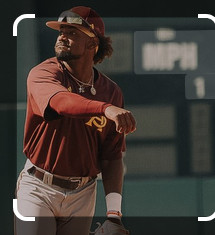
Looking at second basemen who were drafted in the lower rounds of the Astros’ draft…and checking in on the Pythag
Looking at the second day of the Astros’ draft, I was struck by the number of hitters who are best characterized as second basemen or at least infield utility players. I’m not including No. 1 pick Neyens, a shortstop whose secondary position is 3b. But maybe the Astros’ decision to select second basemen is simply a matter of liking players who play multiple positions, and 2b is often the ostensible main position for those kinds of versatile players.
On the second day of the draft, the Astros drafted four players who might be viewed as likely second basemen. I think it’s fair to say second base is the home for players who can combine the agility and hands to play second base with at least average to above average offense.
The 2d base draftees may not realize it, but Astros’ second basemen have been among the best in baseball history. Jose Altuve is very likely to be a Hall of Famer when his career is over. Like Altuve, Hall of Famer Craig Biggo played his whole career with the Astros. Add in original Astros second baseman Joe Morgan, who was traded to the Reds midway through his HOF career. Morgan is sometimes called the greatest second baseman of all time. In addition, Nellie Fox, another HOF second baseman, played the last two years of his career with the Astros. Fox helped to mentor Morgan during the early years of Morgan’s career.
Biggio was a first round draft pick, but Altuve and Morgan were signed rather than drafted. Interestingly, scouts downgraded both Altuve and Morgan as “too small” to become major league players.
So, no pressure on these draftees to become star second basemen, but it’s nice to see the legacy that the Astros have enjoyed at the position.
If you want information on the Astros’ draftees on the second day, the MLB.com summary is here.
NIck Monistere, 4th round. The 21 year old second baseman at Southern Miss University was born in Sugarland Texas. His second year stats in college: .323/.410/.623/ OPS 1.033 He ranked first across the Sun Belt Conference in homers and RBI. Monistere was named the Sun Belt Conference’s 2025 Player of the Year. He has tremendous bat speed and is likely to play 2d base. Monistere’s message to Astros’ fans: “They’re gonna get a competitor with me. I’m gonna compete every single day, and I expect to be a big leaguer and win a lot more World Series in my time with the organization, so I’m excited for it.”
Kyle Walker, 8th round. The 22 year old 2d baseman played for Arizona State after transferring from Grambling. The high-energy 5-foot-9 second baseman slashed .352/.449/.546 with 22 stolen bases as a Sun Devil. For his three years of NCAA performance, he has an OPS of 1.039 and a .369 batting average. “He has a knack of getting on base and has good bat-to-ball skills and terrific speed,” according to MLB.com. Mookie Betts is Walker’s favorite baseball player.

Zach Daudet, 10th round. 22 year old Daudet played at Cal Poly San Luis Obispo. The SS/2b slashed .360/.465/.593/ OPS 1.058 in his last season. In four seasons of NCAA play, he posted a .325 BA and .972 OPS. He played all seven positions (except catcher and pitcher) at the Division I level and is a hard-nosed competitor with good bat-to-ball skills. You can watch a HR video here. Daudet talks about the selection by the Astros: “We were talking a good amount and the workout went really well. I loved the front office and all the scouts and people I talked to there. I think it’s a great fit.”
Landon Arroyos, 18th round. This 18 year old middle infield prospect from Grayson HS could stay at shortstop or play 2d base. He is viewed as a development project who has “real shortstop action and hands defensively, but needs to get stronger and faster.” Video of batting practice and fielding here.
Yes, the odds for these players is almost like a lottery ticket. But most of the 2d base picks are versatile and could turn into a valuable utility player. We can hope that one of these guys turn into the next Ben Zobrist. The Astros selected Zobrist in the 6th round from the small school Dallas Baptist University in 2004.
Pythagorean Record
As the Astros head to the post-all star break, we can look at the Pythagorean Record to evaluate the Astros record so far. The two choices are Fangraphs’ Pythagenpat which is a revised version or the traditional Pythagorean Record at Baseball-Reference But in this case, both produce the same result. The Astros are over-performing their Pythag by two games. Why are they over-performing? This is one of the much discussed mysteries of sabermetrics. Obviously it could just be random chance. The bullpen, particularly the high leverage back of the bullpen, has been shown to have some statistical effect on over- or under-performing the pythag. Some people have claimed that managerial decision making affects pythagorean performance. That has never been proven (and I’m not sure how you would prove it). So, you can offer your own view for explaining Pythag performance.
The Fangraphs’ gives the Astros 73% Division Odds and 94% odds of making the playoffs. The odds of taking a “bye” position in the playoffs has declined slightly below 50% at 48%. The Astros are expected to have a .524 Win Percent for the rest of the season, according to the FG model.